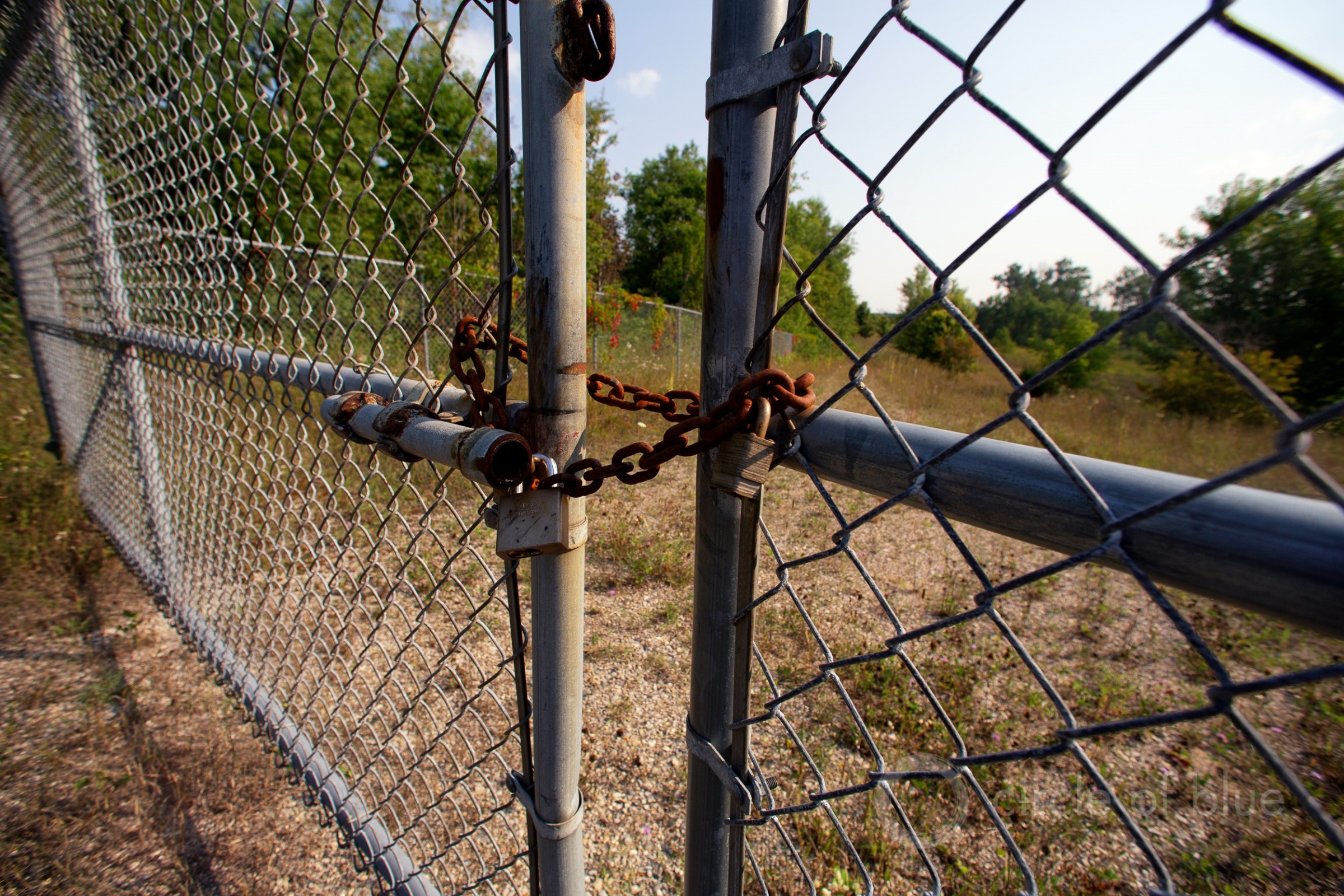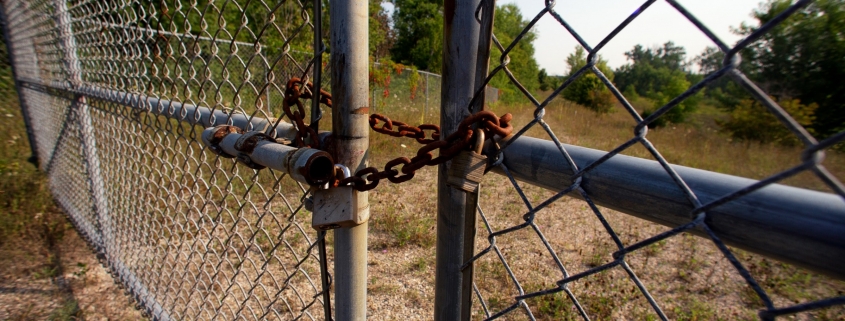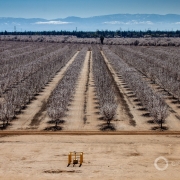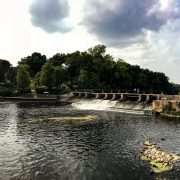Who Pays? PFAS Lawsuits, Legislation Raise Question of Pollution Liability
Wastewater utilities, whose facilities are a conduit for chemical pollution, object to Democratic proposals in Congress that could hold them liable for the cost of PFAS removal.

Locked gates prevent entry at Wolverine World Wide property in Kent County, Michigan. The site was closed in order to investigate the source of PFAS contamination. Photo © J. Carl Ganter/Circle of Blue
By Brett Walton, Circle of Blue
A potential lawsuit in North Carolina and legislation in Congress have together surfaced an under-the-radar debate about who shoulders the burden of preventing contamination of waterways with toxic PFAS chemicals.
On one side are wastewater utilities, who view themselves as conduits for pollution, not its creators. They do not want to be held liable for the steep cost of removing PFAS chemicals — costs that would then be passed along to city residents in the form of higher sewer bills.
On the other side are citizen groups and lawmakers, who are scrambling to find immediate legal, technical, and policy fixes for a class of manmade chemicals that has thousands of variations, several of which have been shown to damage human health even at outrageously tiny concentrations.
Prized for their ability to repel liquids and resist flames, these “forever chemicals” — so named because their strong atomic bonds do not easily break down — have been incorporated into consumer and industrial products as varied as carpets, clothing, cookware, food packaging, and firefighting foams.
The pressures of expediency and responsibility are now colliding in the legal arena.
Three months ago, Haw River Assembly, a North Carolina environmental group, filed a notice of intent to sue the City of Burlington for allegedly discharging PFAS chemicals in its treated wastewater into the Haw River, in violation of the Clean Water Act.
The notice also alleges that the city is violating a second federal statute — the Resource Conservation and Recovery Act — because the chemicals are in the solid waste that emerges from the wastewater plant. Called biosolids, the solid waste is spread on farm fields and can be another pathway for PFAS contamination of water and food.
At the same time, Congress is considering legislation that would designate all PFAS chemicals as hazardous substances under a third federal statute: the Superfund law, also known as CERCLA. Such an action would provide the leverage to compel polluters to pay for the cleanup of contaminated sites.
Taken together, the legal and legislative developments have opened new angles in the country’s PFAS response, experts say.
When Jessie King, an attorney at Williams Mullen who focuses on environmental law, heard of the intent to sue Burlington, she said that she was not surprised. Companies like 3M and DuPont, which had manufactured the chemicals, had already been the target of state and local government lawsuits seeking to recover costs.
Likewise, a number of utilities — from Westfield, Massachusetts, to Suffolk County Water Authority, in New York — have successfully clawed back millions of dollars from the U.S. military as reimbursement for the cost of removing PFAS chemicals from drinking water.
King, and other observers, told Circle of Blue that they had not seen any legal action specifically directed at wastewater utilities for PFAS contamination, but given muddled federal policy and the scale of the problem, King figured it was only a matter of time.
“I saw that this would be the next step, because wastewater treatment plants get water from so many sources,” King said. “They are a logical target.”
Hoping to Shed That Target
Legal liability is the core concern for wastewater utilities. And liability is a core issue for Superfund.
Designating a chemical as a hazardous substance under Superfund is meant to help fund the cleanup of contaminated sites by holding the polluters responsible for the cost.
For PFAS chemicals, there is no political consensus on the correct course of action. A hazardous substance designation that was championed by House Democrats was removed from a Defense authorization bill last December because it could not garner enough support.
For wastewater utilities, there is a major drawback to a hazardous substance designation, said Nathan Gardner-Andrews, chief advocacy officer for the National Association of Clean Water Agencies, a lobby group. Superfund is a strict liability law, meaning that any entity that conveys a pollutant can be held responsible for it, even if the entity did not produce it.
The association supports a hazardous substance label for PFAS, Gardner-Andrews told Circle of Blue. But it does not want its members and their ratepayers exposed to the costs of treatment, which could be substantial depending on the size of the utility and scope of pollution.
The association presented Congress with suggested language on exempting wastewater treatment plants for Superfund liability, but that language was ignored.
“It’s frustrating for us,” Gardner-Andrews explained, describing his group’s interactions with members of Congress. “We’ve been talking about this issue since last spring. They understand the theoretical position, but they feel that they can’t give one group an exemption because it will open the gates and everyone will want one.”
Despite that potential side effect, Congress is considering giving an exemption to a particular sector.
The PFAS Action Act, which the House passed in January, includes a provision that exempts from CERCLA liability municipal airports that share facilities with a federal government agency, such as a branch of the military. The reasoning is that Federal Aviation Administration rules required that airports use certain firefighting foams that contained PFAS chemicals. These airports, the argument goes, had no say in the matter.
“In our view, our argument is no different,” Gardner-Andrews replied. “We’re required under law to treat every drop that comes into our system. If you’re going to exempt airports because they have no choice but to use the foams, then we feel the same reasoning should apply to wastewater plants.”
Maggie Rousseau, a spokesperson for Rep. Debbie Dingell, the Michigan Democrat who sponsored the bill, directed questions to the House Energy and Commerce Committee. Committee representatives did not respond before deadline.
The White House said that President Trump would veto the bill, partly because of costs for municipalities.
A similar bill introduced in the Senate by Bernie Sanders would also designate all PFAS chemicals as hazardous substances under CERCLA. The Sanders bill, however, does not have any exemptions.
Option of Last Resort
Because of the legal uncertainty, environmental groups are using the available tools to force action on what they see as an urgent problem. Lawsuits are one of those tools.
“We want to solve the problem as fast and as effectively as possible,” Emily Sutton told Circle of Blue.
Sutton is the Haw Riverkeeper, a role that positions her as an advocate for the river. Formerly a center of textile manufacturing, the Haw River begins in northern North Carolina, near Greensboro. It is a tributary of the Cape Fear River, another North Carolina waterway that has been plagued by PFAS contamination.
Elaine Chiosso, executive director of Haw River Assembly, said the lawsuit was a last resort.
“It was finally the avenue we took after feeling like we were not getting anywhere, not getting any information about the sources of PFAS,” Chiosso told Circle of Blue.
Haw River Assembly filed the notice of intent to sue last November. Federal statutes provide a 90-day waiting period for the parties to negotiate a solution. That 90-day period ends on February 12.
Chiosso and Sutton said that discussions with Burlington, to this point, have been productive.
“So far, they are really forthcoming with data,” Sutton said. Burlington agreed to monitor wastewater at the 13 industrial facilities that discharge into the city’s sewers.
“Burlington is an environmentally conscious community and City staff is committed to protecting the environment on a daily basis,” John Vernon, a Burlington spokesperson, wrote to Circle of Blue in an email. “The City is also responsive to concerns of community stakeholders including the Haw River Assembly.”
Neither Chiosso nor Sutton could say, at this point, what factors would determine whether Haw River Assembly withdraws the notice or proceeds with the lawsuit.
Working on Local Solutions
Chiosso and others see a potential remedy in a Clean Water Act provision. That law allows utilities to require dirty industries that discharge wastewater into the municipal sewer system to “pretreat” their waste stream, scrubbing out the harmful pollutants before they enter the municipal treatment plant.
In effect, pretreatment standards shift the cost burden from municipal ratepayers to the responsible industry.
Michigan regulators have used a pretreatment program to identify PFAS discharges to municipal sewers in that state. The program, which just ended its second year, has dramatically reduced PFAS loads in rivers. It’s the type of progress that Chiosso would like to see from the textile manufacturers and industrial coating facilities upstream of Burlington.
Pretreatment for PFAS chemicals, however, is not so easy, according to King. The U.S. Environmental Protection Agency does not regulate the chemicals in industrial wastewater discharges. Unless required by the state, manufacturers do not test for the chemicals, utilities are not required to remove them, and there are no standards for the chemicals in biosolids or wastewater.
“Nobody was prepared for this,” King said.
Utilities do have some leverage against industrial discharges through the pretreatment program. But for PFAS, which do not have federal limits, that puts the utilities in an uncomfortable situation of being arbiters of chemical standards, King said. Also, the EPA notes that there is little data available on which treatment technologies are effective for removing PFAS in industrial wastewater.
In North Carolina, wastewater utilities are in charge of the pretreatment programs and they are the ones to decide which industries need to treat their discharges and to what level, according to Sarah Young, a spokesperson for the North Carolina Department of Environmental Quality.
For King, lawsuits like the one that might be filed against Burlington can be catalysts for long-delayed conversations about waste discharges and treatment standards.
“It’s a difficult position for both sides to be in,” she said. “But lawsuits will force those conversations to happen.”
Brett writes about agriculture, energy, infrastructure, and the politics and economics of water in the United States. He also writes the Federal Water Tap, Circle of Blue’s weekly digest of U.S. government water news. He is the winner of two Society of Environmental Journalists reporting awards, one of the top honors in American environmental journalism: first place for explanatory reporting for a series on septic system pollution in the United States(2016) and third place for beat reporting in a small market (2014). He received the Sierra Club’s Distinguished Service Award in 2018. Brett lives in Seattle, where he hikes the mountains and bakes pies. Contact Brett Walton











Leave a Reply
Want to join the discussion?Feel free to contribute!